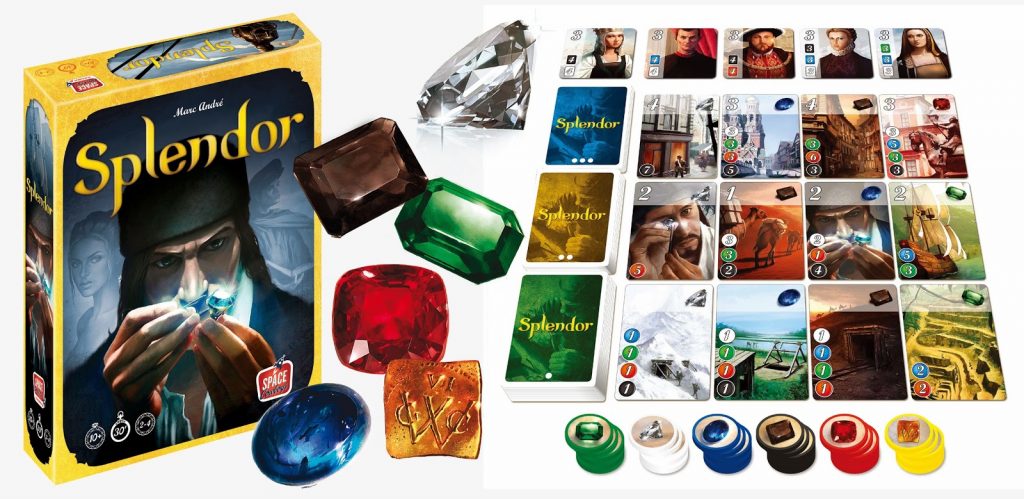Splendor: a Splendid Way to Spend an Evening
by Yvonne Hanson © Gifts for Card Players
Since buying this game last year, it has gradually become a fixture of our friend-group hangout nights. The phrase “I would play splendoooooor” is heard almost every time we are deciding what to do next, and as long as two other people agree, we’re more than likely to play a round or two. One game of Splendor takes around 25 minutes to play, making it the perfect game for some quick, noncommittal friendly competition.
Splendor players take on the role of merchants of the Renaissance purchasing gem mines, transportation and shops. Players collect two or three differently coloured tokens each turn, which can be used to purchase and collect cards. Cards function as tokens as well, but do not have to be given up when used to purchase other cards.
There are five colours of cards and tokens, each kind marked by a different a shiny gemstone (which, lets be honest, feel pretty good to collect and arrange in front of you). There are also four randomly selected ‘noble’ cards which can be claimed when a player reaches the number of each colour of card that the noble specifies.
By claiming a noble or buying more expensive higher-tier cards, players will earn victory points. Victory is awarded to the first player to rack up fifteen victory points, unless someone else is able to get more victory points by the end of the next round of turns.
With a few extra considerations, these simple mechanics are pretty much all there is to it. We have introduced several friends and relatives to this game over the past year because it isn’t hard to teach or to learn, and by the second game new players are adequately initiated and able to start strategizing and competing. In total, it takes about an hour to go from complete-newbie to full-fledged competitor. And while they’re learning, players will enjoy the feel of the weighted game pieces and their beautiful illustrations.
Despite its simplicity, Splendor is riddled with opportunity for strategy. For a while when we first started playing, I was testing a different strategy every single game. It’s possible to focus only on your own tiles and build up your cards and tokens in complete isolation of other player’s influence. It’s also possible to focus only on other players, undermining their plans and actions by claiming cards they need or building towards the same noble.
Recently, we invested in the Splendor expansion set, which includes four new game modes. I was concerned that the expansion would add unnecessary elements and complications to an already seamless game. However, after playing through each one, I can confidently confirm that the expansion modes are just as well-designed as the classic edition, adding four new strategic angles without interfering with the core elements of the game.
If you have found a strategy that works in the classic game, you can likely play the same strategy in the expansions as though nothing has changed. Alternatively, you could devise a new strategy for each expansion mode that plays into the unique elements of each mode. This flexibility without compromise is truly a testament to the quality of this game’s design.
If you have a group of game-loving friends or family members who are frequently looking for something interesting to do together, it might be worthwhile to pick up a copy of Splendor the next time you visit your local game shop.
Or you can purchase it on Amazon by clicking on the image. Note: there are no actual gems included in the box. At least, not the box we played out of.






